
Year 1160 (MCLX) was a leap year starting on Friday of the Julian calendar.
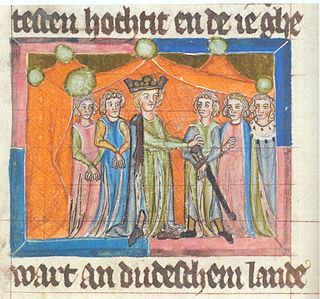
Year 1184 (MCLXXXIV) was a leap year starting on Sunday of the Julian calendar.

The Castle of Almourol is a medieval castle atop the islet of Almourol in the middle of the Tagus River, located in the civil parish of Praia do Ribatejo, 4 kilometres (2.5 mi) from the municipal seat of Vila Nova da Barquinha, in Portugal's Centre Region. The castle was part of the defensive line controlled by the Knights Templar, and a stronghold used during the Portuguese Reconquista.

Abū Yūsuf Yaʿqūb ibn Yūsuf ibn Abd al-Muʾmin al-Manṣūr, commonly known as Yaqub al-Mansur or Moulay Yacoub, was the third Almohad Caliph. Succeeding his father, al-Mansur reigned from 1184 to 1199. His reign was distinguished by the flourishing of trade, architecture, philosophy and the sciences, as well as by victorious military campaigns in which he was successful in repelling the tide of the Reconquista in the Iberian Peninsula.

Dom Gualdim Pais, a Portuguese crusader, Knight Templar in the service of Afonso Henriques of Portugal. He was the founder of the city of Tomar.

Alcácer do Sal is a municipality in Portugal, located in Setúbal District. The population in 2011 was 13,046, in an area of 1499.87 km2.

Battle of Alarcos, was a battle between the Almohads led by Abu Yusuf Ya'qub al-Mansur and King Alfonso VIII of Castile. It resulted in the defeat of the Castilian forces and their subsequent retreat to Toledo, whereas the Almohads reconquered Trujillo, Montánchez, and Talavera.
This is a timeline of notable events during the period of Muslim presence in Iberia, starting with the Umayyad conquest in the 8th century.
This is a historical timeline of Portugal.

The Castle of Paderne is an ancient fortification located in the civil parish of Paderne, municipality of Albufeira, in the Portuguese Algarve. It was constructed in the later 12th century by Berbers, in an area around 7.5 kilometres (4.7 mi) inland.
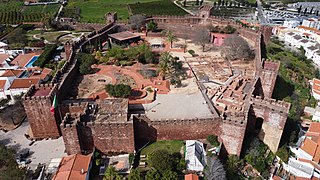
The Castle of Silves is a castle in the civil parish of Silves in the municipality of Silves in the Portuguese Algarve. It's believed that the first fortifications were built upon a possible Lusitanian castro, by the Romans or Visigoths. Between the 8th and 13th centuries, the castle was occupied by the moors who expanded it, making it one of the best preserved Moorish fortifications in Portugal, resulting in its classification as a National Monument in 1910.
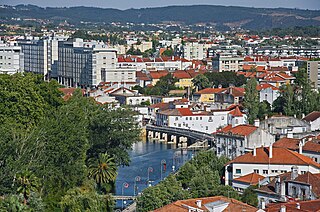
Tomar, also known in English as Thomar, is a city and a municipality in the Santarém district of Portugal. The town proper has a population of about 20,000. The municipality population in 2011 was 40,677, in an area of 351.20 km2 (135.60 sq mi).
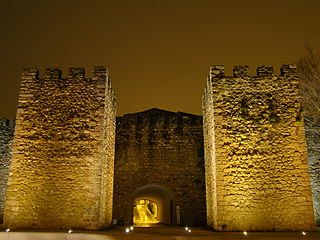
The Castle of Lagos is a medieval castle located in the municipality of Lagos, Portugal. Its walls surrounded the entire city of Lagos, providing the town its main means of defence.

The Military Order of Christ was founded in 1318. The order, in every sense of the term, were Knights Templar who continued their operations from their headquarters in Tomar, Santarém Portugal. Contrary to the belief that the Templar Order was renamed and established by King Denis of Portugal, the Templars merely moved backed to their original headquarters in Tomar Castle which was an autonomous zone granted to the Templar Order. Reasons for this move and change of name were to protect the vast assets of the order from repatriation by the Catholic Church. The Templar assets were then transferred over to the Cavaleiros de Cristo, all with the blessing of King Diniz who helped pull off the deal with the Church.
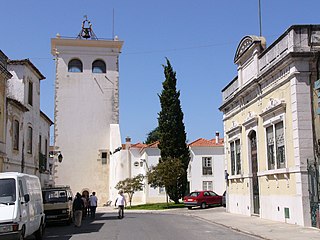
The Castle of Santarém is a medieval castle located in the city of Santarém in the Portuguese county and district of Santarém.
The Almohad Caliphate launched a major offensive against the Kingdom of Portugal in the spring of 1190 that lasted into the summer of 1191. The Caliph Yaʿqūb al-Manṣūr crossed over from Africa to take personal command of his forces. The campaign of 1190 was underwhelming because of assistance Portugal received from passing armies of the Third Crusade. The sieges of Tomar, Santarém and Silves had to be abandoned, but the caliph overwintered in Seville. The campaign of 1191 reversed Portugal's recent reconquests, captured Silves after a second siege and pushed the frontier north to the Tagus.
The Alvor massacre took place in June 1189 during the Third Crusade, when a fleet of crusaders from the Holy Roman Empire, Denmark and the County of Flanders stormed the castle of Alvor in the Algarve, then part of the Almohad Caliphate, and massacred 5,600 people. The place of the conquest and massacre of Alvor in the Portuguese Reconquista is unclear, but there are grounds for thinking that it was part of the strategy of King Sancho I, who launched a siege of Silves a month later.

The siege of Silves was an action of the Third Crusade and the Portuguese Reconquista in 1189. The city of Silves in the Almohad Caliphate was besieged from 21 July until 3 September by the forces of Portugal and a group of crusaders from northern Europe on their way to the siege of Acre. The defenders capitulated on terms, the city was handed over to Portugal and the crusaders took a portion of the spoils.

The siege of Alcácer do Sal lasted from 30 July to 18 October 1217. The well fortified city of Alcácer do Sal was a frontier outpost of the Almohad Caliphate facing Portugal. It was besieged by forces from Portugal, León, the military orders and the Fifth Crusade. The latter were led by Count William I of Holland. The expedition was the brainchild of Bishop Soeiro II of Lisbon, whose diocese was threatened by regular raids from Alcácer. King Afonso II of Portugal did not take part in person, but the city was incorporated into his kingdom after its capitulation. The crusaders who took part in the siege, mainly from the Rhineland and the Low Countries, did so without papal authorization and were afterwards ordered to continue on to the Holy Land.

Portuguese participation in the Reconquista occurred from the moment the County of Portugal was founded in 868 and continued for 381 years until the last cities still in Muslims control in the Algarve were captured in 1249.

















